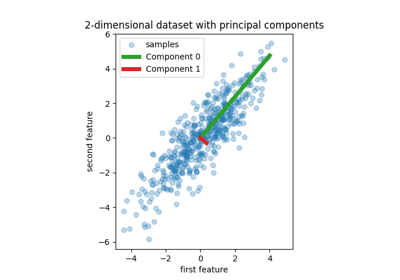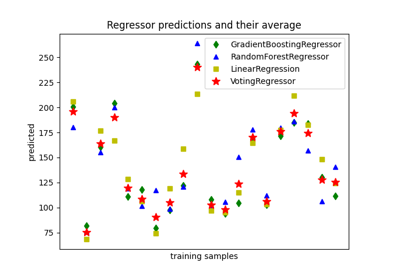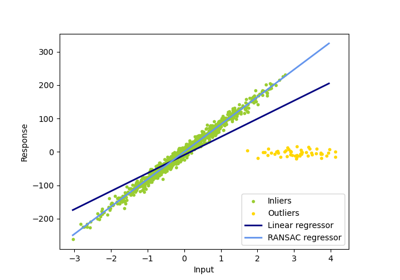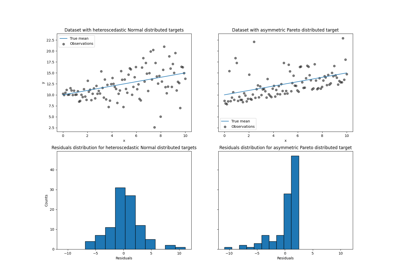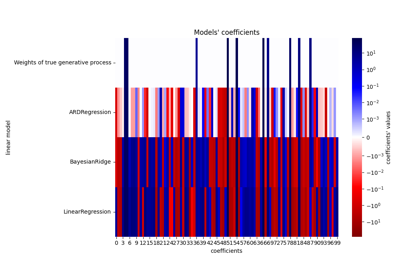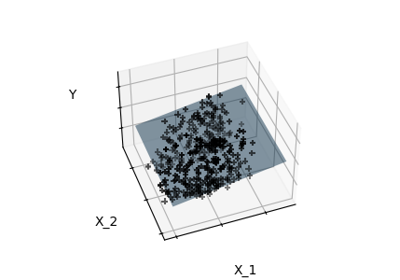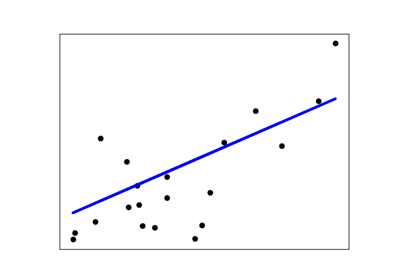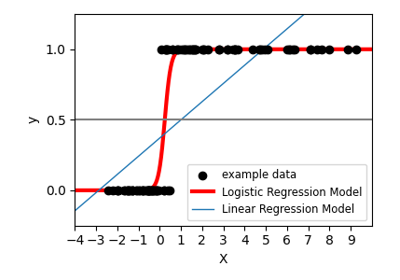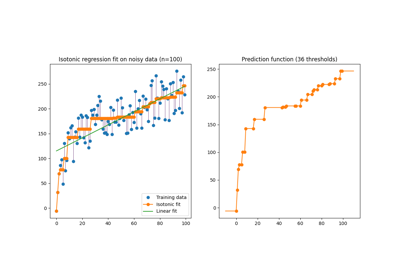LinearRegression#
- class sklearn.linear_model.LinearRegression(*, fit_intercept=True, copy_X=True, n_jobs=None, positive=False)#
普通最小二乘线性回归。
LinearRegression 通过系数 w = (w1, …, wp) 拟合一个线性模型,以最小化数据集中观察到的目标与线性近似预测的目标之间的残差平方和。
- Parameters:
- fit_interceptbool, default=True
是否计算此模型的截距。如果设置为 False,则在计算中不使用截距(即数据应已中心化)。
- copy_Xbool, default=True
如果为 True,将复制 X;否则,可能会覆盖它。
- n_jobsint, default=None
用于计算的作业数。这仅在问题足够大时提供加速,即首先
n_targets > 1,其次X是稀疏的或positive设置为True。None意味着 1,除非在joblib.parallel_backend上下文中。-1意味着使用所有处理器。有关更多详细信息,请参阅 Glossary 。- positivebool, default=False
当设置为
True时,强制系数为正。此选项仅支持密集数组。Added in version 0.24.
- Attributes:
- coef_array of shape (n_features, ) or (n_targets, n_features)
线性回归问题的估计系数。如果在拟合过程中传递了多个目标(y 2D),则这是一个形状为 (n_targets, n_features) 的 2D 数组,而如果只传递了一个目标,则这是一个长度为 n_features 的 1D 数组。
- rank_int
矩阵
X的秩。仅当X是密集时可用。- singular_array of shape (min(X, y),)
矩阵
X的奇异值。仅当X是密集时可用。- intercept_float or array of shape (n_targets,)
线性模型中的独立项。如果
fit_intercept = False,则设置为 0.0。- n_features_in_int
在 fit 过程中看到的特征数。
Added in version 0.24.
- feature_names_in_ndarray of shape (
n_features_in_,) 在 fit 过程中看到的特征名称。仅当
X的特征名称均为字符串时定义。Added in version 1.0.
See also
RidgeRidge 回归通过 l2 正则化对系数的大小施加惩罚,解决了普通最小二乘法的一些问题。
LassoLasso 是一种线性模型,通过 l1 正则化估计稀疏系数。
ElasticNetElastic-Net 是一种线性回归模型,通过 l1 和 l2 正则化训练系数。
Notes
从实现的角度来看,这只是普通的普通最小二乘法(scipy.linalg.lstsq)或非负最小二乘法(scipy.optimize.nnls)作为预测器对象的包装。
Examples
>>> import numpy as np >>> from sklearn.linear_model import LinearRegression >>> X = np.array([[1, 1], [1, 2], [2, 2], [2, 3]]) >>> # y = 1 * x_0 + 2 * x_1 + 3 >>> y = np.dot(X, np.array([1, 2])) + 3 >>> reg = LinearRegression().fit(X, y) >>> reg.score(X, y) 1.0 >>> reg.coef_ array([1., 2.]) >>> reg.intercept_ 3.0... >>> reg.predict(np.array([[3, 5]])) array([16.])
- fit(X, y, sample_weight=None)#
拟合线性模型。
- Parameters:
- X{array-like, sparse matrix},形状为 (n_samples, n_features)
训练数据。
- yarray-like,形状为 (n_samples,) 或 (n_samples, n_targets)
目标值。如有必要,将被转换为 X 的数据类型。
- sample_weightarray-like,形状为 (n_samples,),默认=None
每个样本的单独权重。
Added in version 0.17: 参数 sample_weight 支持 LinearRegression。
- Returns:
- selfobject
拟合的估计器。
- get_metadata_routing()#
获取此对象的元数据路由。
请查看 用户指南 以了解路由机制的工作原理。
- Returns:
- routingMetadataRequest
MetadataRequest封装的 路由信息。
- get_params(deep=True)#
获取此估计器的参数。
- Parameters:
- deepbool, 默认=True
如果为True,将返回此估计器和包含的子对象(也是估计器)的参数。
- Returns:
- paramsdict
参数名称映射到它们的值。
- predict(X)#
使用线性模型进行预测。
- Parameters:
- Xarray-like 或 sparse matrix, shape (n_samples, n_features)
样本。
- Returns:
- Carray, shape (n_samples,)
返回预测值。
- score(X, y, sample_weight=None)#
返回预测的决定系数。
决定系数 \(R^2\) 定义为 \((1 - rac{u}{v})\) ,其中 \(u\) 是残差平方和
((y_true - y_pred)** 2).sum(),而 \(v\) 是总平方和((y_true - y_true.mean()) ** 2).sum()。最好的可能得分是 1.0,它可能是负的(因为模型可能任意地差)。一个总是预测y的期望值的常数模型,忽略输入特征,将得到 \(R^2\) 得分为 0.0。- Parameters:
- Xarray-like of shape (n_samples, n_features)
测试样本。对于某些估计器,这可能是一个预计算的核矩阵或一个形状为
(n_samples, n_samples_fitted)的通用对象列表,其中n_samples_fitted是估计器拟合中使用的样本数量。- yarray-like of shape (n_samples,) or (n_samples, n_outputs)
X的真实值。- sample_weightarray-like of shape (n_samples,), default=None
样本权重。
- Returns:
- scorefloat
\(R^2\) 相对于
y的self.predict(X)。
Notes
在调用回归器的
score时使用的 \(R^2\) 得分从 0.23 版本开始使用multioutput='uniform_average'以保持与r2_score默认值一致。 这影响了所有多输出回归器的score方法(除了MultiOutputRegressor)。
- set_fit_request(*, sample_weight: bool | None | str = '$UNCHANGED$') LinearRegression#
Request metadata passed to the
fitmethod.Note that this method is only relevant if
enable_metadata_routing=True(seesklearn.set_config). Please see User Guide on how the routing mechanism works.The options for each parameter are:
True: metadata is requested, and passed tofitif provided. The request is ignored if metadata is not provided.False: metadata is not requested and the meta-estimator will not pass it tofit.None: metadata is not requested, and the meta-estimator will raise an error if the user provides it.str: metadata should be passed to the meta-estimator with this given alias instead of the original name.
The default (
sklearn.utils.metadata_routing.UNCHANGED) retains the existing request. This allows you to change the request for some parameters and not others.Added in version 1.3.
Note
This method is only relevant if this estimator is used as a sub-estimator of a meta-estimator, e.g. used inside a
Pipeline. Otherwise it has no effect.- Parameters:
- sample_weightstr, True, False, or None, default=sklearn.utils.metadata_routing.UNCHANGED
Metadata routing for
sample_weightparameter infit.
- Returns:
- selfobject
The updated object.
- set_params(**params)#
设置此估计器的参数。
该方法适用于简单估计器以及嵌套对象(例如
Pipeline)。后者具有形式为<component>__<parameter>的参数,以便可以更新嵌套对象的每个组件。- Parameters:
- **paramsdict
估计器参数。
- Returns:
- selfestimator instance
估计器实例。
- set_score_request(*, sample_weight: bool | None | str = '$UNCHANGED$') LinearRegression#
Request metadata passed to the
scoremethod.Note that this method is only relevant if
enable_metadata_routing=True(seesklearn.set_config). Please see User Guide on how the routing mechanism works.The options for each parameter are:
True: metadata is requested, and passed toscoreif provided. The request is ignored if metadata is not provided.False: metadata is not requested and the meta-estimator will not pass it toscore.None: metadata is not requested, and the meta-estimator will raise an error if the user provides it.str: metadata should be passed to the meta-estimator with this given alias instead of the original name.
The default (
sklearn.utils.metadata_routing.UNCHANGED) retains the existing request. This allows you to change the request for some parameters and not others.Added in version 1.3.
Note
This method is only relevant if this estimator is used as a sub-estimator of a meta-estimator, e.g. used inside a
Pipeline. Otherwise it has no effect.- Parameters:
- sample_weightstr, True, False, or None, default=sklearn.utils.metadata_routing.UNCHANGED
Metadata routing for
sample_weightparameter inscore.
- Returns:
- selfobject
The updated object.

